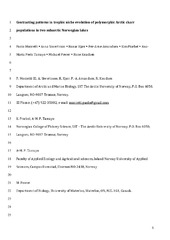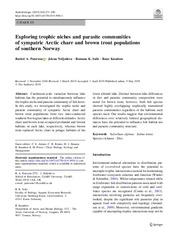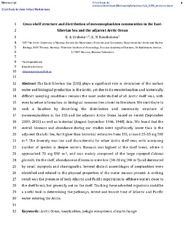Institutt for arktisk og marin biologi: Nye registreringer
Viser treff 1141-1160 av 2084
-
Contrasting patterns in trophic niche evolution of polymorphic Arctic charr populations in two subarctic Norwegian lakes
(Journal article; Tidsskriftartikkel; Peer reviewed, 2019-05-15)Parallelism in trophic niches of polymorphic populations of Arctic charr was investigated in two similar subarctic lakes, Tårnvatn and Skøvatn, in northern Norway. Analysis of eleven microsatellite loci confirmed, respectively, the existence of three and two genetically differentiated morphs. Three methods were used to describe their trophic niches: habitat choice and stomach contents for the recent ... -
Exploring trophic niches and parasite communities of sympatric Arctic charr and brown trout populations of southern Norway
(Journal article; Tidsskriftartikkel; Peer reviewed, 2019-05-09)Catchment-scale variation between lake habitats has the potential to simultaneously influence the trophic niche and parasite community of fish hosts. In this study, we investigated the trophic niche and parasite community of sympatric Arctic charr and brown trout populations from two inter-connected southern Norwegian lakes at different altitudes. Arctic charr and brown trout occupied profundal and ... -
From clear lakes to murky waters – tracing the functional response of high-latitude lake communities to concurrent ‘greening’ and ‘browning’
(Journal article; Tidsskriftartikkel; Peer reviewed, 2019-02-21)Climate change and the intensification of land use practices are causing widespread eutrophication of subarctic lakes. The implications of this rapid change for lake ecosystem function remain poorly understood. To assess how freshwater communities respond to such profound changes in their habitat and resource availability, we conducted a space‐for‐time analysis of food‐web structure in 30 lakes ... -
Simulating more realistic predation threat using attack playbacks
(Journal article; Tidsskriftartikkel; Peer reviewed, 2019-12-19)Use of virtual proxies of live animals are rapidly gaining ground in studies of animal behaviour. Such proxies help to reduce the number of live experimental animals needed to stimulate the behaviour of experimental individuals and to increase standardisation. However, using too simplistic proxies may fail to induce a desired effect and/or lead to quick habituation. For instance, in a predation ... -
Phthalate metabolites in harbor porpoises (Phocoena phocoena) from Norwegian coastal waters
(Journal article; Tidsskriftartikkel; Peer reviewed, 2020-02-03)The exposure of marine mammals to phthalates has received considerable attention due to the ubiquitous occurrence of these pollutants in the marine environment and their potential adverse health effects. The occurrence of phthalate metabolites is well established in human populations, but data is scarce for marine mammals. In this study, concentrations of 17 phthalate metabolites were determined in ... -
Pelagic occurrences of the ice amphipod Apherusa glacialis throughout the Arctic
(Journal article; Tidsskriftartikkel; Peer reviewed, 2020-01-10)<i>Apherusa glacialis</i> is a common, sea ice-associated amphipod found throughout the Arctic Ocean and has long been considered permanently associated with the sea ice habitat. However, pelagic occurrences of <i>A. glacialis</i> have also been reported. It was recently suggested that <i>A. glacialis</i> overwinters at depth within the Atlantic-water inflow near Svalbard, to avoid being exported ... -
Dietary variation in Icelandic arctic fox (Vulpes lagopus) over a period of 30 years assessed through stable isotopes
(Journal article; Tidsskriftartikkel, 2019-12-21)Identifying resources driving long-term trends in predators is important to understand ecosystem changes and to manage populations in the context of conservation or control. The arctic fox population in Iceland has increased steadily over a period of 30 years, an increase that has been attributed to an overall increase in food abundance. We hypothesized that increasing populations of geese or seabirds ... -
Unique genetic features of canine adenovirus type 1 (CAdV-1) infecting red foxes (Vulpes vulpes) in northern Norway and arctic foxes (Vulpes lagopus) in Svalbard
(Journal article; Tidsskriftartikkel; Peer reviewed, 2019-03-02)Canine adenovirus type 1 (CAdV-1) is the aetiological agent of infectious canine hepatitis (ICH) in domestic dogs (<i>Canis familiaris</i>). In spite of the widespread use of vaccination, CAdV-1 continues to circulate in the dog population. Although a high number of serological screenings have indicated that CAdV-1 is widespread in fox species, little is known about the potential role of foxes as ... -
Identifying key needs for the integration of social-ecological outcomes in arctic wildlife monitoring
(Journal article; Tidsskriftartikkel; Peer reviewed, 2018-11-24)For effective monitoring in social–ecological systems to meet needs for biodiversity, science, and humans, desired outcomes must be clearly defined and routes from direct to derived outcomes understood. The Arctic is undergoing rapid climatic, ecological, social, and economic changes and requires effective wildlife monitoring to meet diverse stakeholder needs. To identify stakeholder priorities ... -
The effect of long-range transport, trophic position and diet specialization on legacy contaminant occurrence in great skuas, Stercorarius skua, breeding across the Northeast Atlantic
(Journal article; Tidsskriftartikkel; Peer reviewed, 2018-10-08)High levels of halogenated organic contaminants (HOCs) have been found in the marine predatory seabird great skua (<i>Stercorarius skua</i>) from breeding colonies in the Northeastern Atlantic, with large unexplained inter-colony variation. The present study aimed at analyzing if the HOCs occurrence in breeding great skuas in remote colonies was explained by local baseline food web exposure determined ... -
Effects of mine tailings exposure on early life stages of Atlantic cod
(Journal article; Tidsskriftartikkel; Peer reviewed, 2019-03-22)In Norway, mine tailings waste can be deposited by coastal submarine dispersal. Mine tailings slurry includes fine particles <10 µm with elevated levels of metals (e.g., copper, iron) from residual mineral ore. Prolonged suspension of small particles in the water column may bring them into contact with locally spawned pelagic fish eggs, including Atlantic cod, <i>Gadus morhua</i>. Newly fertilized ... -
First record of cuticle bands in the stomach ossicles of the red king crab Paralithodes camtschaticus (Tilesius, 1815) (Decapoda: Anomura: Lithodidae) from Norway.
(Journal article; Tidsskriftartikkel; Peer reviewed, 2019-09-09)The red king crab Paralithodes camtschaticus (Tilesius, 1815) is a large predator intentionally introduced to the Barents Sea and adjacent fjords in the 1960s. Its establishment has given rise to both a high-value fishery and destructive effects on seafloor habitats and communities. Given the need for accurate information on age, growth, and longevity that could improve management and mitigation ... -
Pelagic occurrences of the ice amphipod Apherusa glacialis throughout the Arctic
(Journal article; Tidsskriftartikkel; Peer reviewed, 2020-01-10)<i>Apherusa glacialis</i> is a common, sea ice-associated amphipod found throughout the Arctic Ocean and has long been considered permanently associated with the sea ice habitat. However, pelagic occurrences of <i>A. glacialis</i> have also been reported. It was recently suggested that <i>A. glacialis</i> overwinters at depth within the Atlantic-water inflow near Svalbard, to avoid being exported ... -
The urgency of Arctic change
(Journal article; Tidsskriftartikkel; Peer reviewed, 2018-11-27)This article provides a synthesis of the latest observational trends and projections for the future of the Arctic. First, the Arctic is already changing rapidly as a result of climate change. Contemporary warm Arctic temperatures and large sea ice deficits (75% volume loss) demonstrate climate states outside of previous experience. Modeled changes of the Arctic cryosphere demonstrate that even ... -
MapMan4: a refined protein classification and annotation framework applicable to multi-omics data analysis.
(Journal article; Tidsskriftartikkel; Peer reviewed, 2019-01-09)Genome sequences from over 200 plant species have already been published, with this number expected to increase rapidly due to advances in sequencing technologies. Once a new genome has been assembled and the genes identified, the functional annotation of their putative translational products, proteins, using ontologies is of key importance as it places the sequencing data in a biological context. ... -
Cross-shelf structure and distribution of mesozooplankton communities in the East-Siberian Sea and the adjacent Arctic Ocean
(Journal article; Tidsskriftartikkel; Peer reviewed, 2019-06-29)The East-Siberian Sea (ESS) plays a significant role in circulation of surface water and biological production in the Arctic, yet due to its remote location and historically difficult sampling conditions remains the most understudied of all Arctic shelf seas, with even baseline information on biological communities absent in literature. We aim to fill this gap by describing the distribution and ... -
Global diversity and geography of planktonic marine fungi
(Journal article; Tidsskriftartikkel; Peer reviewed, 2019-07-24) -
Soil protist diversity in the Swiss western Alps is better predicted by topo-climatic than by edaphic variables
(Journal article; Tidsskriftartikkel; Peer reviewed, 2019-11-01)<i>Aim</i> - Trends in spatial patterns of diversity in macroscopic organisms can be well predicted from correlative models, using topo‐climatic variables for plants and animals allowing inference over large scales. By contrast, diversity in soil microorganisms is generally considered as mostly driven by edaphic variables and, therefore, difficult to extrapolate on a large spatial scale based on ... -
Deepened winter snow significantly influences the availability and forms of nitrogen taken up by plants in High Arctic tundra
(Journal article; Tidsskriftartikkel; Peer reviewed, 2019-05-13)Climate change may alter nutrient cycling in Arctic soils and plants. Deeper snow during winter, as well as summer warming, could increase soil temperatures and thereby the availability of otherwise limiting nutrients such as nitrogen (N). We used fences to manipulate snow depths in Svalbard for 9 consecutive years, resulting in three snow regimes: 1) <i>Ambient</i> with a maximum snow depth of ... -
Soil organic carbon depletion and degradation in surface soil after long-term non-growing season warming in High Arctic Svalbard
(Journal article; Tidsskriftartikkel; Peer reviewed, 2018-07-26)Arctic tundra active-layer soils are at risk of soil organic carbon (SOC) depletion and degradation upon global climate warming because they are in a stage of relatively early decomposition. Non-growing season (NGS) warming is particularly pronounced, and observed increases of CO<sub>2</sub> emissions during experimentally warmed NGSs give concern for great SOC losses to the atmosphere. Here, we ...


 English
English norsk
norsk


















